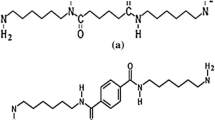Abstract
Hyperbranched aqueous poly(urethane–urea) (HBAPU) was synthesized via A2 + bB2 approach using 2,4-tolylene diisocyanate, polycarbonatediol, dimethylol propionic acid and diethanol amine as materials. The structure of the products were characterized by FT-IR and 13C NMR. The results showed that the degree of the branching increased with increasing the molar ratio of the nNCO/nOH. The particle size, thermal and mechanical properties were measured by photon correlation spectroscopy, thermal gravimetric analysis and tensile tests, respectively. The particle size of HBAPU was much smaller than that of linear aqueous polyurethane; thermal stability of HBAPU enhanced with decreasing the molar ratio of nNCO/nOH. The tensile tests revealed that HBAPU exhibited excellent tensile properties and the maximum tensile strength was up to 33 MPa.







Similar content being viewed by others

References
Cheng KC, Chuang TH, Chang JS, Guo W, Su WF (2005) Effect of feed rate on structure of hyperbranched polymers formed by self-condensing vinyl polymerization in semibatch reactor. Macromolecules 38:8252–8257. doi:10.1021/ma050640s
Vogl O, Jaycox G (1999) “Trends in polymer science”: polymer science in the 21st century. Prog Polym Sci 24:3–6. doi:10.1016/S0079-6700(98)00019-7
Kim YH, Webster OW (1992) Hyperbranched polyphenylenes. Macromolecules 25:5561–5572. doi:10.1021/ma00047a001
Wooley KL, Fréchet JMJ, Hawker CJ (1994) Influence of shape on the reactivity and properties of dendritic, hyperbranched and linear aromatic polyesters. Polymer 35:4489–4495. doi:10.1016/0032-3861(94)90793-5
Yang G, Jikei M, Kakimoto M (1999) Synthesis and properties of hyperbranched aromatic polyamide. Macromolecules 32:2215–2220. doi:10.1021/ma981590c
Jena KK, Chattopadhyay DK, Raju KVSN (2007) Synthesis and characterization of hyperbranched polyurethane–urea coatings. Eur Polym J 43:1825–1837. doi:10.1016/j.eurpolymj.2007.02.042
Liu HB, Jiang A, Guo J, Uhrich KE (1999) Unimolecular micelles: synthesis and characterization of amphiphilic polymer systems. J Polym Sci Part A: Polym Chem 37:703–711. doi:10.1002/(SICI)1099-0518(19990315)37:6<703::AID-POLA5>3.0.CO;2-O
Emrick T, Chang HT, Fréchet JMJ, Woods J, Baccei L (2000) Hyperbranched aromatic epoxies in the design of adhesive materials. Polym Bull 45:1–7. doi:10.1007/s002890070061
Voit B (2005) Hyperbranched polymers-all problems solved after 15 years of research. J Polym Sci Part A: Polym Chem 43:2679–2699. doi:10.1002/pola.20281
Kumar A, Ramakrishnan S (1996) Hyperbranched polyurethanes with varying spacer segments between the branching points. J Polym Sci Part A: Polym Chem 34:839–848. doi:10.1002/(SICI)1099-0518(19960415)34:5<839::AID-POLA13>3.0.CO;2-J
Hong L, Cui Y, Wang X, Tang XZ (2002) Synthesis of a novel one-pot approach of hyperbranched polyurethanes and their properties. J Polym Sci Part A: Polym Chem 40:344–450. doi:10.1002/pola.10102
Spindler R, Fréchet JMJ (1993) Two-step approach towards the accelerated synthesis of dendritic macromolecules. J Chem Soc Perkin Trans 1(24):913–918. doi:10.1039/P19930000913
Spindler R, Fréchet JMJ (1993) Synthesis and characterization of hyperbranched polyurethanes prepared from blocked isocyanate monomers by step-growth polymerization. Macromolecules 26:4809–4813. doi:10.1021/ma00070a013
Kumar A, Ramakrishnan S (1993) A novel one-pot synthesis of hyperbranched polyurethanes. J Chem Soc Chem Commun 24:1453–1454. doi:10.1039/C39930001453
Bruchmann B, Wingerter F, Graf H, Wolff S (1999) Highly functional polyurethanes. US Patent 5,981,684
Feast WJ, Rannard SP, Stoddart A (2003) Selective convergent synthesis of aliphatic polyurethane dendrimers. Macromolecules 36:9704–9706. doi:10.1021/ma035511v
Clark AJ, Echenique J, Haddleton DM, Straw A, Taylor PC (2001) A nonisocyanate route to monodisperse branched polyurethanes. J Org Chem 66:8687–8689. doi:10.1021/jo016075i
Bruchmann B (2007) Dendritic polymers based on urethane chemistry–syntheses and applications. Macromol Mater Eng 292:981–992. doi:10.1002/mame.200700119
McKee MG, Unal S, Wilkes GL, Long TE (2005) Branched polyesters: recent advances in synthesis and performance. Prog Polym Sci 30:507–539. doi:10.1016/j.progpolymsci.2005.01.009
Fornof AR, Glass TE, Long TE (2006) Degree of branching of highly branched polyurethanes synthesized via oligomeric A2 plus B3 methodology. Macromol Chem Phys 207:1197–1206. doi:10.1002/macp.200600096
Sahre K, Elrehim MHA, Eichhorn KJ, Voit B (2006) Monitoring of the synthesis of hyperbranched poly(urea–urethane)s by real-time attenuated total reflection (ATR)-FT-IR spectroscopy. Macromol Mater Eng 291:470–476. doi:10.1002/mame.200500358
Unal S, Yilgor I, Yilgor E, Sheth JP, Wilkes GL, Long TE (2004) A new generation of highly branched polymers: hyperbranched, segmented poly(urethane urea) elastomers. Macromolecules 37:7081–7084. doi:10.1021/m1049472e
Lin Q, Long TE (2003) Polymerization of A2 with B3 monomers: a facile approach to hyperbranched poly(aryl ester)s. Macromolecules 36:9809–9816. doi:10.1021/ma0257447
Abdelrehim M, Komber H, Langewalter J, Voit B, Bruchamann B (2004) Synthesis and characterization of hyperbranched poly(urea–urethane) based on AA* and B2B* monomers. J Polym Sci Part A: Polym Chem 42:3062–3081. doi:10.1002/pola.20154
Elrehim MA, Voit B, Bruchmann B, Eichhorn KJ, Grundke K, Bellmann C (2005) Structure and end-group effects on bulk and surface properties of hyperbranched poly (urea urethane)s. J Polym Sci Part A: Polym Chem 43:3376–3393. doi:10.1002/pola.20822
Gao C, Yan D (2003) “A2 + CBn” approach to hyperbranched polymers with alternating ureido and urethane units. Macromolecules 36:613–620. doi:10.1021/ma021411y
Gao C, Yan D (2004) Hyperbranched polymers: from synthesis to applications. Prog Polym Sci 29:183–275. doi:10.1016/j.progpolymsci.2003.12.002
Kim B, Yang J, Yoo S, Lee J (2003) Waterborne polyurethanes containing ionic groups in soft segments. Colloid Polym Sci 281:461–468. doi:10.1007/s00396-002-0799-4
Lu MG, Lee JY, Shim MJ, Kim SW (2002) Synthesis and properties of anionic aqueous polyurethane and dispersions. J Appl Ploym Sci 86:3461–3465. doi:10.1002/app.10770
Noble KL (1997) Waterborne polyurethanes. Prog Org Coat 32:131–136. doi:10.1016/S0300-9440(97)00071-4
Samy A, Madbouly, Joshua U (2006) Kinetic analysis of fractal gel formation in waterborne polyurethane dispersions undergoing high deformation flows. Macromolecules 39:4144–4151. doi:10.1021/ma060049a
Hölter D, Burgath A, Frey H (1997) Degree of branching in hyperbranched polymers. Acta Polym 48:30–35. doi:10.1002/actp.1997.010480105
Ishida Y, Sun ACF, Jikei M, Kakimoto M (2000) Synthesis of hyperbranched aromatic polyamides from dendrons as monomers: effect of monomer multiplicity on the degree of branching. Macromolecules 33:2832–2838. doi:10.1021/ma992021n
Acknowledgments
The research was supported by Innovation Group Foundation and Elitist Foundation of the Provincial Science and Technology Department, Hubei, China
Author information
Authors and Affiliations
Corresponding author
Rights and permissions
About this article
Cite this article
Liu, D., Zeng, S., Yao, C. et al. Synthesis and properties of hyperbranched aqueous poly(urethane–urea) via A2 + bB2 approach. Polym. Bull. 63, 213–224 (2009). https://doi.org/10.1007/s00289-009-0087-2
Received:
Revised:
Accepted:
Published:
Issue Date:
DOI: https://doi.org/10.1007/s00289-009-0087-2



